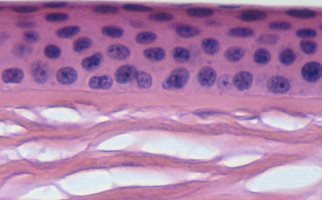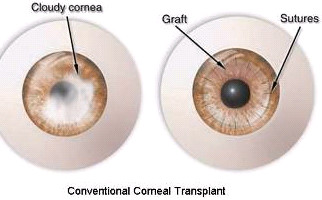Cornea
What exactly is the cornea?
Cornea is the sensitive, transparent layer of the eye, exposed to light and needs to remain clear for good vision. This anterior tunic, because of its curvature, is the more refractive surface of the eye and responsible for visual stimuli focus on the retina. Cornea’s functionality is similar to a photographic camera mirror. Corneal thickness is normally between 460 and 630 microns. Pachymetry is useful information during preoperative check, before a laser refractive procedure (excimer laser).
The corneal structure consists of the following layers:
- Epithelium
- Bowman’s membrane
- Stroma
- Descemet’s membrane
- Endothelium
What exactly is a corneal transplantation (keratoplasty procedure) and when it takes place?
Since the cornea is basically an exposed tunic, it is possible to be injured or even infected. So serious injuries, widespread infections, advanced keratoconus, hereditary diseases, opacities, deformities, increased curvature change or scars are some of the causes that lead to a corneal transplantation surgical procedure solution. Corneal transplantation (keratoplasty surgical procedure) is the process of replacing the cornea or a part of it with a cornea of a suitable donor.
Usually a corneal transplantation procedure is successful. A case failure is due to a cornea graft rejection (when human body takes a graft as foreigner and attempts to abort it), resulting in graft blurring. When a graft rejection is promptly and properly faced, in 90% of all cases the condition is reversible with the help of special drugs. Thus, graft will remain clear and the corneal transplantation procedure will be considered as successful.
Corneal transplantation (keratoplasty) techniques:
By taking into consideration the part (thickness) of a corneal graft, keratoplasty surgical procedure is divided into the following 2 basic categories, with each one including extra individual techniques:
-Total corneal transplantation (or penetrating keratoplasty) – (PKP): When the entire corneal thickness is removed and replaced. It has quite a satisfactory success rate and it is possible to be performed under local anesthesia. This surgical procedure requires a high level surgical knowledge and skillful maneuvers, as it is based on very thin graft suturing.
-Partial corneal transplantation (or lamellar keratoplasty): In some cases it is preferable to selectively replace only a specific section of the cornea (e.g. only a part of stromal layer). Then the procedure is called lamellar (partial) keratoplasty and is divided into the following 2 subcategories:
a. Anterior lamellar keratoplasty (DALK, ALTK): Replacing only the outer layers of the cornea
b. Posterior lamellar keratoplasty (DSEK, DSAEK, DMEK): Replacing only the posterior layers of the cornea
Keratoprosthesis: A technique, mainly used when sever, bilateral vision loss (corneal blindness) is observed, due to a keratopathy or a penetrating (total) keratoplasty failure. In keratoprosthesis, an artificial (plastic) cornea is placed on the eye, through a special microsurgical procedure, in order to fully replace the problematic one.

















